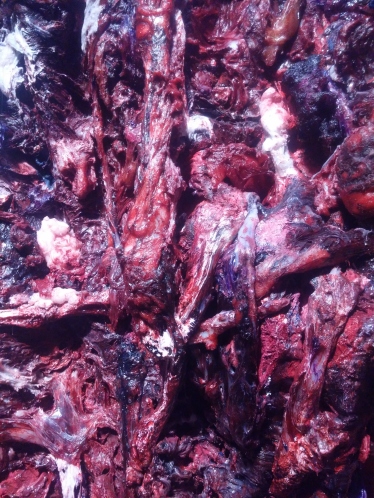“Kwetsbaar lillend vlees
Ongebroken scheppingskracht
De nachtwacht houden” – Eugeen

This afternoon I visited the Rijksmuseum in Amsterdam with two of my guests from Belgium. At the Rijks, there are currently three works on display from the contemporary artist Anish Kapoor. This triptych, which is called “Internal object in three parts” is very daringly displayed in the “Gallery of Honour” of the museum, which is devoted to masterpieces by illustrious Dutch painters such as Jan Steen, Johannes Vermeer and above all Rembrandt.
The choice is very daring indeed, because the works are an expressionistic depiction of something, which resembles blood, meat, muscle tissue and fat tissue. The most adequate description would be that the works depict a rabbit which was put in a shredder. The works are made of silicon and color pigment. Passing visitors, when confronted with this work in the most classical of museum wings, posed the eternal question: “Is this art?”, thereby implying: “This is not art.”

Opposite the Anish Kapoor reliefs was one of my favourite works of Rembrandt in the Rijksmuseum: “The Syndics”. On this picture, we see six Dutch burghers, apparently surprised by the entrance of the spectator. In a most delicate way, Rembrandt breaks through the “fourth wall” of the painting. In the juxtaposition with Kapoor’s carnal festival, the glances of the “inspectors of dyed cloth” become even more poignant. As if they are inspecting and judging the appearance of these peculiar presences in the room. “Mene, mine, tekhel, upharsin.”
Kapoor’s works demands attention. In an interview in NRC Handelsblad, Kapoor has expressed his suspicion that his show at the Rijksmuseum might become an exercise of humility for him. But despite the condescending murmur you hear when you stroll through the “Gallery of Honour”, the context of the 17th Century masterpieces is necessarily and irrevocably changed by Kapoor’s critical expressionism. They present an aesthetic of the sublime next to works which were created in an age where beauty was the only aesthetic. Kapoor therefore reminds us, that it has become impossible to genuinely repeat the spirit of the Golden Age.
Ineffable